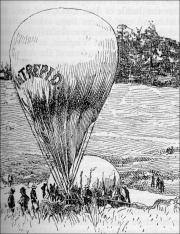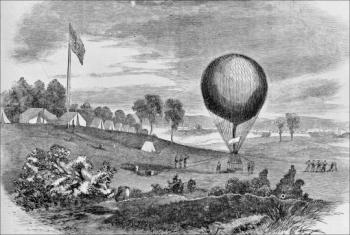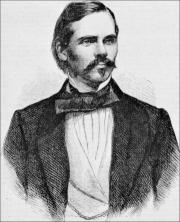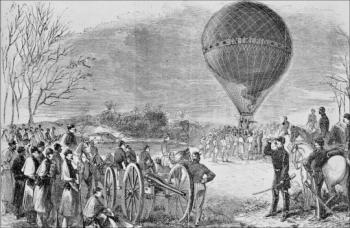 |
Observations From Above
By Jake Brouwer
 |
Before take off, a reporter from the Cincinnati Daily Commercial pleaded with Lowe to take with him copies of his newspaper. This would prove from where the Professor had left on his enterprising flight that day and accounts of the event. Lowe accepted and stuffed them into the depths of the balloon's basket. Lowe who had attended an evening party earlier that evening was still dressed in evening attire complete with his black top hat. The winds were proper and he had to leave right then to demonstrate his case. The balloon climbed to the Northwest and then gradually as it hit the upper air currents, it turned to the East. Telegraph reports from Lexington, Kentucky confirmed that the balloon was indeed headed swiftly to the East.
The air stream took him to heights of up to four miles and still propelling in an easterly direction. Once over the Alleghenies the balloon dropped a mile a minute and before long he was able to hear the roar of cannon coming from below. He was unaware that they belonged to Virginians celebrating their succession from the Union. When he reached an area where things had quieted down, Lowe ventured a decent to the earth below. He calculated that he was somewhere in South Carolina. He had traveled 800 miles in 9 hours. For the times this was an amazing accomplishment.
Once upon the ground he was greeted by farmers from the surrounding communities carrying shot guns instead of pitchforks. "Shoot the Yankee!" Was the greeting he received. They thought he was a
Union spy as he disembarked from the basket in his evening coat.The farmers loaded him, his balloon, and apparatus into a wagon and left for Unionville, South Carolina. There he was herded in with "Yankee abolitionists" being held in a hotel. The landlord of the hotel recognized Professor Lowe from a previous balloon accession and was quite aware of his scientific experiments. Together they attempted to persuade the Confederate soldiers that Lowe was not a spy. Lowe remembered the Cincinnati newspapers describing the flight stashed in the bottom of his basket. This firmed up his innocence and he was released. Because of this ordeal he was considered one of the earliest prisoners of war. The locals then treated him with a great deal more respect. Not as much as he probably deserved but then after all he was a Yankee. After a slight bit of fanfare Lowe was hustled onto a train and 5 days later he arrived in Cincinnati. He traveled the same distance a few days earlier in only 9 hours.
 |
Professor Lowe invented a portable gas
generator allowing balloons to be filled in the field. |
After this harrowing experience Professor Lowe shelved his
Trans-Atlantic trip and decided to offer his aeronautical skills to the government.
President Abraham
Lincoln checked Professor Lowe’s credentials and after
being assured he was the best
person for the job, Lowe was brought to Washington for a
demonstration. The Professor took his balloon up to a height of 500 feet and with the help
of a battery to provide current he then proceeded to telegraph a message to the president
using a Morse instrument.
The message read:
To his Excellency, Abraham Lincoln, President of the United States
Dear Sir:
From this point of observation we command an extent of country nearly fifty miles in diameter. I have the pleasure of sending you this first telegram ever dispatched from an aerial station, and acknowledging indebtedness to your encouragement for the opportunity of demonstrating the availability of the service of aeronautics in the service of the country. I am, Your Excellency’s obedient servant,
T. S. C. Lowe
This aerial transmission was another great achievement by Lowe and military leaders were quick to realize its importance. Lincoln gave Lowe a note clearing the way to start the Aeronautic Corps.
Lowe was encountered at first with some resistance from General Winfield Scott, "The Grand Old Man." It took a personal visit from Lincoln to get the ball rolling again.
The Balloon Corps, as it came to be known, fought through vast amounts of military red tape to get its job accomplished, but finally its main
 |
Balloon preparing for a reconnaissance mission at General McDowell's
headquarters. |
objective, reconnaissance, was put to work. Lowe and his team found that they were great targets for the confederate soldiers. Carl Sandberg wrote that Lowe was "The most shot-at man in the war.
Lowe took draftsmen up into the balloon with him so the army engineers could make better maps. These maps would be of a great boon to relic hunters and historians as their accuracy was impeccable. Previously the maps drawn of enemy positions were greatly distorted.
Lowe used his own apparatus and even paid the men in his service from his own pocket in the beginning. The military shifted him from one branch to another. From the Corps of Engineers, to Quartermaster, and then to Signal Corps and back again. Finally after much pleading he received funds to build five new much-needed balloons. The largest were the Intrepid and the Union. They were 65 and 38 feet in diameter. Patriotic women were recruited to do the sewing of more than 1200 yards of India silk in making the balloons. The outlay to make each balloon was around $1000 to $1200.00.
On one of his early flights from Fort Corcoran Lowe describes gliding along Warrenton Turnpike to Stone Bridge. He says, "The countryside is devastated as if attacked by fire-breathing locusts." On a rise in front of him were the ruins of two farmhouses, Stone House and Henry House, both surrounded by the debris of battle. Confederate, and Federal troops had fought back and forth here across Henry Hill. Later in the war Thaddeus Lowe was also involved in spotting for artillery fire. While Confederate troops lay sleeping he directed the artillery fire that got them up and running away from Falls
Church. The Confederate batteries on Munsons’ Hill shot back at the only thing they could see which was Professor Lowes’ balloon. When he arrived back at the base of operations General Porter congratulated Lowe for the success of the flight's mission. Porter, pointing to a large cannon hole in the bottom of Lowe’s basket advised the Professor to line his balloon with a sheet of metal. It was promptly done.
In time Lowe came to recognize the rows of humps on distant hills as rows of tents and by counting them, Generals like Joe Hooker who went up more than once in the balloon, could calculate how many troops were in the area. Low hanging clouds on the horizon were actually clouds of dust kicked up by troop movements on the road. Judging by the appearance and size of the clouds Lowe eventually could distinguish how many men were marching, or if it was cavalry, or horses and wagons. He learned what smoke was from rifle or cannon fire, and what was trash burning compared to cooking dinner for the troops.
A balloon camp called Camp Lowe was established at Edward’s Ferry near Harper’s Ferry. Its duty was the protection of Washington on the Northwest. At one point in the camps career two confederate spies were captured that told of a $1000 gold reward and a commission was to be given to the man that destroyed a balloon.
 |
Porfessor T.S.C. Lowe at the age of 27 |
As the army made its way to the Confederate capitol at Richmond, Professor Lowe and General Stoneman got their first view of the city and it's surrounding battle trenches. They looked down on it from a hill above the Chickahominy River called Gaines Hill. Stoneman wanted it for his artillery and Lowe for his balloons. The height of the hill was a definite advantage, however the trees hid many of the rebel troops. Going aloft, Lowe and Stoneman were able to push back the rebels but more importantly noticed that it was at Mechanicsville that the Virginia Central Railroad supplied the city of Richmond. The Union troops took Mechanicsville and from their positions there they could see with telescopes into the very streets of the capitol. The balloon Intrepid played a major part in turning the attack of the Confederates at the battle of Fair Oaks later that month by relaying the positions of the troops to awaiting commanders in the field below. President Lincoln was able to follow almost the entire battle as if he were there because of the telegraph messages sent from the balloon.
A visitor arrived one day to observe the balloon operations and Lowe simply not having the time to deal with it turned away the young Count Ferdinand von Zeppelin. It would have been his first balloon ride.
T. S. C. Lowe also was the first person to propel an aeronautical device from the deck of a ship while anchored in the Potomac River, therefore in essence the first aircraft carrier.
 |
Professor Lowe about to make an ascension in Virginia |
Lowe was an undeniable presence in many battle scenes of the Civil War. His vision of aerial observations of enemy troop movements was a monumental concept that has been continued now into the space age. Satellites now have the ability to practically peek over our shoulders as we work. Professor Lowe came to Southern California after the war and had another vision. It was an incline railroad that could transport local and worldly tourists from the foothills of Altadena to the heights of Echo Mountain. On July 4th, 1893 The Mt. Lowe Railroad officially took its first passengers up the 62% grade incline to Echo Mountain. Hotels, a zoo, and an observatory greeted the tourists at various stages of development. Later the Professor built an Alpine Division of the railroad that wound around the mountain up to another resort at nearly 5000 feet, known as the Alpine Tavern. This area had tennis courts, a fox farm, its own newspaper, and a miniature golf course. The views of the valley below were spectacular. From a spot that became known as Inspiration Point a visitor could see as far away as Catalina Island.
The millions of visitors that came to its lofty heights from 1893 until it was shut down completely in 1937 witnessed the vision of Thaddeus Lowe. It was the Disneyland of its time bringing
city folk and flatlanders into the wilds of the San Gabriel Mountains. The Pacific Electric Railroad eventually bought the entire complex and brought fares down to a price that millions more could afford. It was a world class attraction.
Unfortunately this area now known for its high winds and fires was destroyed piece by piece. The wind storms literally blew away what fires did not burn. Today the foundations of the buildings still remain. It is a ghost town, if you will, overlooking the sprawling metropolis of Los Angeles.
Whether from a balloon or from the peaks of a mountain top Thaddeus Lowe sought to reach up to the clouds. It was his goal to improve his and others' powers of observation of the things around us. His observations of the enemy in the Civil War were invaluable. Also the sights he saw from the top of Mt. Lowe were so astonishing he had to share them with the rest of the earth, thereby opening his Mt. Lowe Railroad.
Send email to Echowebmaster@aaaim.com to report any problems.
Last modified: February 12, 1999
No part of this paper may be
reproduced in any form without written permission from:
Jake Brouwer
All articles and photos were provided by:
Land-Sea Discovery Group
Copyright © 1999